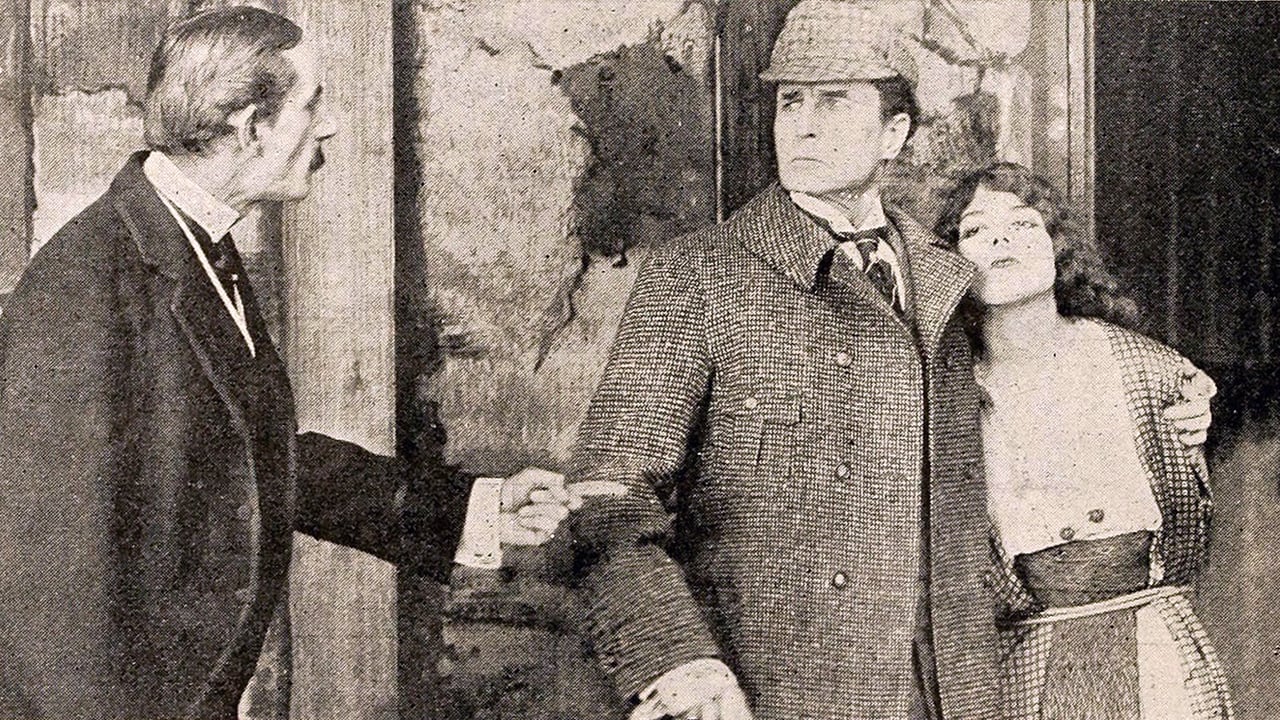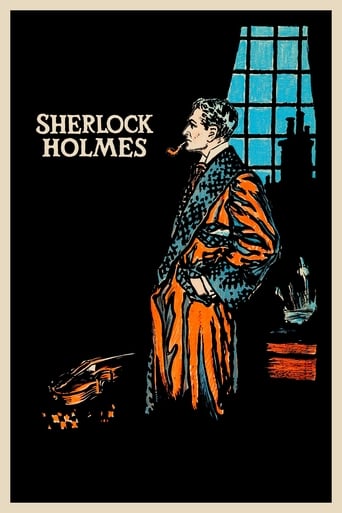


Sherlock Holmes (1916) *** (out of 4)A member of the Royal family writes some letters to a woman who suffers from a broken heart and dies. Her sister Alice (Marjorie Kay) gains possession of the letters and the Royal family wants them back. A couple blackmailers learn of the letters so they kidnap Alice and plan on using the letters for money but Sherlock Holmes (William Gillette) also has an interest in them.SHERLOCK HOLMES was a lost film for decades but thankfully a print from France showed up. I'm not going to lie. I love silent movies and each year it seems more and more films are being discovered, which is great but I've noticed that a lot of the films aren't all that good. Even if they aren't that good it's always great when one is discovered. SHERLOCK HOLMES, on the other hand, is actually a very good movie and it turns out to be a real discovery.Gillette was one of the most famous actors of his time and he did a tremendous tour playing Holmes, which took him around the world. Whenever someone thought of Holmes it was Gillette that they thought of and you can see certain things that would be borrowed by future actors. It's almost hard to believe but this here was Gillette's only film and it was produced by the Essanay Company after they lost Charlie Chaplin.The film is pretty much what you would have seen on the stage at the time so it's fascinating getting to see the film. Gillette certainly makes for a very good Holmes as he certainly has command of the character and a certain grace that really jumps off the screen. It's rather shocking that this was Gillette's only time in front of the camera because he really comes off as a natural. Kay is also very good in her role as is Ernest Maupain as Professor Moriarty and Edward Fielding as Dr. Watson.SHERLOCK HOLMES features a story written by Gillette and it too is very good and manages to hold you attention for a few minutes shy of two hours. The movie has a terrific pace to it and it's well-shot. This film is so much better than the 1922 version with John Barrymore so film buffs have a lot to celebrate with this one turning up.
... View MoreSHERLOCK HOLMES (Essanay, 1916), directed by Arthur Berthelet, is not the first nor the last motion picture produced depicting on the most recognizable and famous fictional detective of all time, Sir Arthur Conan Doyle's Sherlock Holmes. What makes this edition so special is it's historical account and reproduction and cast reprising their original roles from the popular stage play, notably William Gillette (1855-1937), the actor long associated with the title role decades before Basil Rathbone won that honor though his 14-film theatrical series produced by Universal in the 1940s. Anyone familiar with the carnation of Rathbone (Sherlock Holmes) and Nigel Bruce (Doctor Watson) would immediately realize how little the renown forties series and Gillette's screen adaptation have nothing in common, not even any by-plays and great chemistry between Holmes and Watson that made the Universal films work so well.As with many silent films of this nature, prints to SHERLOCK HOLMES have been lost to extinction until (according to the title cards with tiny printing readable only through the use of a magnifying glass) inserted prior to the opening credits), "a print was discovered in France 2014, with French-language inter-titles translated back to English." Another interesting fact is that this 1916 production was initially released as a seven reel feature while the European release in 1920 was extended with French inter-titles formatted into a four-part chaptered serial edition: ( "The Prince's Letters," "Moriarty vs. Sherlock Holmes," "A Tragic Night," and "The Triumph of Sherlock Holmes"). The restored 116 minute, color-tinted, accu-speed silent film process, completed by January 2015, would make its world television premiere October 18, 2015, on Turner Classic Movies cable channel.Following the opening sequence capturing the legendary stage actor, William Gillette, as Sherlock Holmes, working on experiments in his laboratory, the introduction of its supporting players of the four-act story are as follows: The Larrabees, James (Mario Majeroni) and Madge (Grace Reals), unscrupulous adventurers; Alice Faulkner (Marjorie Kay), a young girl whose abused sister, now deceased, having been entrusted the indiscreet love letters written to her by the crown prince; Baron Von Stalburg (Ludwig Kreiss), the prince's assistant, and Sir Edward Leighton (Stewart Robbins), a British official, knowing the great value of those letters, attempting to retrieve them; Sid (William Postance), a resourceful cracks-man and member of the Larrabee gang; and Doctor Watson (Edward Fielding), Holmes' occasional confident. As Sherlock Holmes is hired to retrieve the stolen letters, as well as protect and later rescue the abducted Alice, the ace detective also encounters his arch enemy, Professor Moriarty (Ernest Maupain), getting into the act with the villains while at the same time avenging himself on Holmes; and Billy (Burford Hampden), a boy secretly assisting Holmes supplying him with some valuable information needed for his investigation.Considering when SHERLOCK HOLMES was made, one can forgive primitive stand-still camera technique and limited visual close-ups on central characters most associated with movies nowadays. The acting style and method of storytelling can prove disappointing to contemporary viewers, which in fact, it is. At least it wasn't too stage bound.As much as it's a film buffs dream having lost silent movies rediscovered and available for viewing again, especially the opportunity of seeing the actual visual image of William Gillette captured on film, rather than associating his name with his Gillette Castle home overlooking the Connecticut River. The disappointment in general lies mostly by its new scoring that accompanies this movie. Definitely not for its listening pleasure considering this being shown for the first time in nearly a century. The piano accompaniment is okay, but its overuse of violin playing simply ruins it. This film deserves better. Had SHERLOCK HOLMES been discovered in the 1960s, no doubt it would have sufficed on public television during the nostalgia boom of the 1970s with excellent William Perry piano or Gaylord Carter organ scoring from the Killiam Collection. A pity this didn't happen here.The title SHERLOCK HOLMES would be used again in latter screen adaptations: (Goldwyn, 1922) starring John Barrymore (Holmes), Carol Dempster (Alice Faulkner) and Roland Young (Doctor Watson); and (Fox, 1932), talkie edition with the Gillette look-alike Clive Brook (Holmes), Miriam Jordan (Alice Faulkner) and Reginald Owen (Doctor Watson), all forgotten editions with limited reissues and appeal in modern times, yet there's more to Sherlock Holmes of the movies than anyone would come to realize. This is one of them. (**)
... View MoreThere are two things to recommend this film. First of all, it is in marvelous condition for something made in 1916. Secondly, we get to see the famous William Gilette, who played the great detective over 1000 times on the stage. This version is the stage version, sans most of the dialogue. The story is a bit confusing at first, but it involves a young woman whose sister had an affair with royalty. She has letters that would prove embarrassing to a prince. Holmes has been hired to get those letters (like in "A Scandal in Bohemia"). There are a man and his wife, the Larabees, who also want to get their hands on those letters in order to turn a profit. Enter Moriarity, Holmes' arch rival. There are a series of ridiculous plots that don't work because people are stupid. The young woman is clueless. She also becomes a love interest for Holmes. This is out of bounds in the canon. One thing lacking is that Holmes is uninteresting and dull. He is coy and sad. His overconfidence is his greatest trait and he has none of that here. Still, as a period piece, it is fun.
... View MoreThis is the one and only film ever done by actor William Gillette and he was 60 years old at the time, a fact which shows particularly in photos of the photoplay. Also strange is the fact that those who conduct tours at the Gillette Castle in East Haddam, Connecticut don't even seem to know the film was ever made even though they display photos on the walls taken directly from the film.William Gillette has an astounding record in terms of the role of Sherlock Holmes not only because he played the role over 1400 times in three mediums total, but also because he got permission from Conan Doyle himself to do things with the character that were never in print mainly because Doyle was so sickened of the stories that people did not seem to care about any of his other novels and publications. Gillette had no such problem since he relished playing the part particularly since it made him a rather wealthy man as well as a famous one.Gillete also add bits of business that became so associated with the fictional detective that they exist to this day. Things such as the curved Meerchaum pipe and the dressing gown he so often wears in his digs at 221 B Baker Street. And in the last few serialized Sherlock Holmes stories in the American magazine Colliers, the illustrator intentionally made the detective hero look just like William Gillette.Samuel French still prints the play and it was performed by no less than the Royal Shakespeare Company on Broadway as well as on the Wezt Coast. Still, when it was performed at the Williamsburg festival, there were changes made in the stage play making one wonder if there was more than one version of the play. Still these two things - the printed play and the videotaped production are all we have to go on in what this film may have been like since no print seems to exist.Then there is the 1922 Sanuel Goldwyn film starring John Barrymore which tantalizes us further. While many here on this site have lambasted that version, it appears by all accounts to have been wildly successful.SPOILER ALERT: Gillette in his version marries off Holmes to the character of Alice Faulkner who seems to have been based on the literary character known as "THE Woman" by Sherlock Holmes himself in a story in the Canon. Her name was Irene Adler.Reportedly, when Gillette asked the creator Conan Doyle if he could marry him off, he was known to have said "You may damn well kill him off if you wish" As I have said in my summary title, I do hope that one day this film will resurface and be seen at all. One can only dream.
... View More